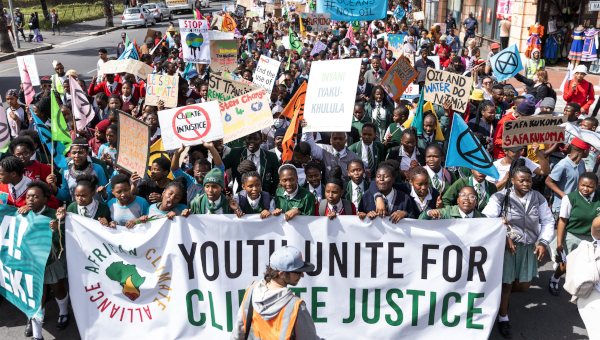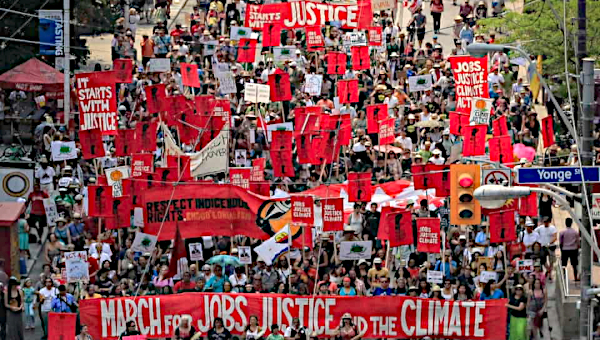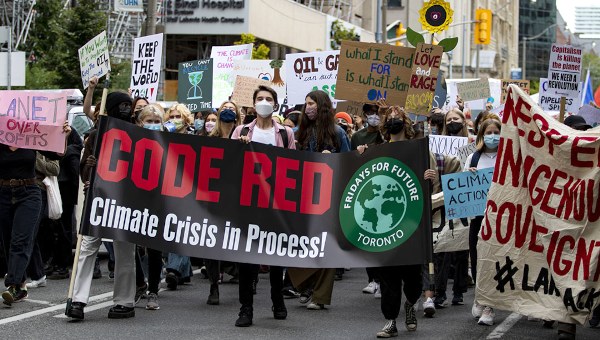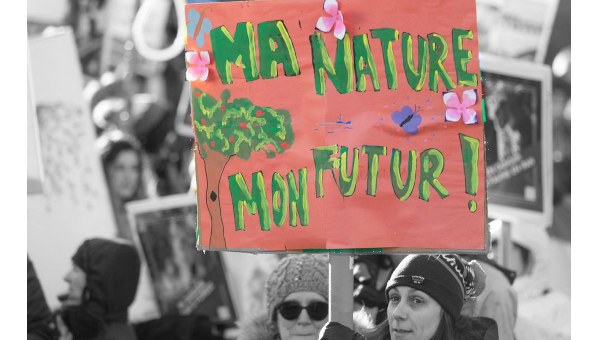Climate Mobilization in View of the COP26
1. Disasters, of which extreme weather events linked to climate change are the main cause, have doubled in 20 years, killing more than 1.2 million people worldwide since 2000. Record summer temperatures in the Northern and the Southern Hemisphere (including the Arctic and Antarctica), deadly fires, exceptionally mild, snow-free winters in many areas, monsoon disturbance, more frequent and more extreme weather events: the climate catastrophe is underway. It is progressing faster than the projections, mainly due to the underestimation of the positive feedbacks from global warming. Megafires in Australia have illustrated the major danger of a chain of these feedbacks leading to a rapid and irreversible change in the climate regime. This would notably raise the ocean level by several meters, with terrible consequences for hundreds of millions of human beings, mainly in Asia and Africa, not to mention the disappearance of many island states.

2. As the threat is growing ever faster, the formal decision taken at COP21 (Paris) to “keep global warming well below 2°C while continuing efforts not to exceed 1.5°C compared to the pre-industrial era” has not been implemented even now. COP24 (Katowicze) and COP25 (Madrid), increasingly openly sponsored by capitalist investors, ended in failure. Those mainly responsible are the governments of the United States, China, Brazil and Australia, as well as Saudi Arabia and its Gulf allies. But, beyond the climate-deniers’ blocking manoeuvres, it is fundamentally the impossibility of a green capitalism which is revealed through these failures. Warming cannot be limited below 1.5°C (and even below 2°C) without getting to the root of the problem: capitalist accumulation based on the war of competition for profit, in other words the capitalist mode of production / distribution / consumption based on private property and the exploitation of labour power (which also involves the exploitation of other natural resources).
3. To achieve the objective of COP21, negotiations should aim firstly to bridge the gap between the 1.5°C objective adopted in Paris, on the one hand, and, on the other, the nationally determined contributions, on the basis of which the IPCC projects a warming of 3.3°C by the end of the century. Instead, they have stumbled for five years over on the development of the “new market mechanism” decided in principle in Paris to give increased means to replace emission reductions by so-called “clean investments” generating “Emission rights.” The experience accumulated since the Kyoto Protocol shows that these mechanisms are generally only a means of circumventing effective reductions in emissions and a green neo-colonialism while monopolizing forests and other natural resources, on the backs of the people. But this is precisely the key issue for the capitalists: to make public opinion believe that they are fighting against the catastrophe, while they continue their work of accumulation by dispossession and destruction of biodiversity. Before discussing how to bridge the gap, the capitalists and their political representatives want to know the extent of these possibilities of cheating. This will be the prerequisite for the “raising of ambitions” which ought to be the major issue at COP26 (Glasgow).
4. More than a quarter of a century after the Earth Summit (Rio, 1992) and the adoption of the United Nations Framework Convention on Climate Change, annual CO2 emissions have increased by 60%. The atmospheric concentration of CO2, constantly increasing, is now above 50% preindustrial levels and soon will be above those during the Pliocene (2.6 to 5.3 million years ago), when there was no permanent ice cap in the Northern Hemisphere and the ocean level was about 25 meters higher than today. Whether in the context of COPs or in other forums, climate negotiations are subordinated to the imperatives of capitalist growth and geostrategic rivalries. It is illusory to expect these COPs to adopt measures that are objectively sufficient for a real solution, respecting social justice and North-South climate justice, because this solution is incompatible with capitalist accumulation. In this sense, we support Greta Thunberg’s declaration at COP25 in Madrid that the solution will not come from these negotiations, it can only come from the struggles of the peoples.
5. The years 2019-20 saw a spectacular development of the global climate movement, with high school strikes, sometimes extremely large mass demonstrations (550,000 in Montreal!), civil disobedience actions, occupations aimed at blocking fossil investments, etc. Youth, women, indigenous peoples and peasants confirm their driving role. Eco-anxiety has spawned new action-oriented activist networks (FfF, Rise 2020, XR, etc.), mainly in so-called “developed” countries.
At the same time indigenous movements have continued and often stepped up their organizing against extractive capitalism and the increase in land grabs, theft of seeds and destruction of territories in which they have lived for centuries in relative harmony with Pachamama. Indigenous movements, peasant farmers and women have also taken the lead in a number of other huge mass struggles around the world – in Argentina, Chile, Ecuador, India, etc. – in movements which are not directly centred on ecological demands, but which are essential allies of the climate justice movement. In some contexts, solidarity between movements in the global North and South have been strengthened.
Faced with this, when their attempts at paternalistic recovery and co-optation in the “governance” system no longer work, governments respond with slander, criminalization and repression. This takes particularly violent forms in the face of indigenous peoples and rural communities, many of whose activists are murdered, while forest destroyers and other polluters go unpunished. 11,088 km2 of Amazonian forest have been razed in twelve months, a direct result of Bolsonaro’s extractivist and pro-agrobusiness policy, which also took advantage of the pandemic to act when people might not notice. The acceleration of deforestation and the multiplication of fires are bringing us closer to an irreversible “collapse” of the Amazon. The Fourth International (FI) calls for the broadest solidarity with the victims of this repression and the genocidal project against indigenous peoples. It supports any initiative to boycott multinational or local companies involved in the destruction of the Amazon. Considering the decisive importance of the Amazon rainforest for the ecological balance of the planet, the FI calls for international mobilizations in support of the populations who are trying to resist the ecocidal projects of the Brazilian government.
We support the campaign against the free trade agreement between the European Union and Mercosur, which would have disastrous consequences for the Amazon.
6. The only realistic way to stop the disaster is to work tirelessly toward a long-term, mass global mobilization. We must work to bring together all the social movements of the exploited and the oppressed to bring tirelessly into the streets tens of millions, hundreds of millions of women and men. The precedents of anti-nuclear mobilization in Germany, the massive mobilization against the installation of NATO nuclear missiles in Europe and the global movement against the Iraq War must be our inspiration. Instead of advising policy makers, as some large NGOs do, governments and businesses must be discredited and destabilized ethically, socially and politically. It is only if the ruling class sees its domination threatened that certain currents within it will consider abandoning the neoliberal all-purpose market and start taking the regulatory measures which are essential to partially curb the productivist frenzy.
Partial measures will help to give the social movement confidence in its ability to go further along the path of “System change not climate change.” It is in this spirit that the Fourth International calls for mobilizations everywhere around the COP26 including the largest possible mobilizations in Glasgow itself if the conditions of the pandemic permit this.
This new dynamic in the climate movement has already got off to a promising start. The appeal from the COP26 Coalition for From The Ground Up #1 in November 2020 resulted in the registration of over 8000 activists many from the global south, for five days of discussion, mostly on a very radical basis that was often anti-capitalist and ecosocialist. This indicates the possibilities of bringing together movements from the south and the north, trade unionists and direct action campaigners to push further in this direction.
The Glasgow Agreement process, which is a platform for climate justice action and strategic articulation, currently has over 130 organizations and collective from 40 countries in four continents. This agreement incorporates a political programme for climate justice which is perfectly aligned with ecosocialism and mass direct action on a sustained base, at the local as well as at the international level.
7. The defeat of Trump, the health crisis and its effects on production, but also the improvement of the competitiveness of renewables, particularly in the production of electricity by solar energy (PV solar and onshore wind power are today cheaper than coal and oil, they will soon overtake gas): all these events of the last few months are changing the situation. From now on, the Biden programme, the European Green Deal and the Beijing declarations have in common the “net zero CO2 emissions in 2050.” It seems likely that the USA, China and the EU will converge at COP 26 on a relaunch of the “green capitalism” process decided at COP 21.
However, this convergence is much less than the commitments needed to avoid exceeding 1.5°C. According to the IPCC, to reach this objective, net emissions must fall by 58% globally by 2030 and by at least 65% in the European Union and even more in the USA.
Net Zero emissions is not zero emissions, but “carbon neutrality” compatible with capitalist productivism involving various dangerous false solutions such as nuclear power, different negative-emission technologies for CO2 capture and sequestration, various compensation mechanisms on the backs of the countries of the South and their peoples, and even the deployment of geoengineering. Firmly rooted in the market and competition, this apparently ambitious climate policy turns its back on the principle of common but differentiated responsibilities and opens a new phase of green imperialism. Above all, it is part of a nonsensical scenario of a “temporary overshoot” of the 1.5°C threshold by 2050, followed by a hypothetical cooling down by negative-emission technologies. However, even assuming that this technological cooling is possible, the situation is so critical that an irreversible shift is likely to occur during the so-called “temporary exceedance.” Never before has the absolute antagonism between capitalist accumulation and the limits of the planet been so visible. It directly threatens the physical survival of hundreds of millions of human beings and condemns others (and their children) to live in a devastated world with collapsed biodiversity.
8. The solution to the contradiction between the level of consciousness and objective necessity does not lie in the identification of an immediate demand bridging what seems politically feasible in the current conjuncture, on the one hand, and the radical anti-capitalist programme that is objectively necessary to stop the disaster, on the other hand. Nor does it reside in attempts to artificially impose petitions of revolutionary and ecosocialist principles to the mass movement. The key lies rather in the adoption by the movement of an uncompromising corpus of requirements based both on recognized scientific diagnoses (without catastrophic escalation), on the principles of social justice, equal rights, emancipation and democracy, and on the right of future generations to inherit a planet fit for life.
The Fourth International proposes that the movement concretize this algebraic formula by adopting toward decision-makers an attitude of challenge and distrust on the basis of the following elements:
- emission reduction plans in the various sectors – transport, buildings, energy and agriculture – to stay below 1.5°C.
- the refusal of “temporary overshoot”: As an example, the IPCC places the tipping point of the Greenland ice sheet between 1.5 and 2°C, if it is exceeded, no subsequent cooling will make it possible to go backwards.
- the fight against dangerous technologies (nuclear, GMOs, geo-engineering, BECCS1), no capture and sequestration can be used as an alibi to continue the exploitation of fossil fuels.
- respect for the peoples of the global South and in particular the indigenous peoples, which implies the end of compensation mechanisms. These mechanisms make the global South bear the burden of compensating for the GHGs emitted by and for the richest, expropriating peoples from their lands and forests.
- Climate justice (differentiated responsibilities and capacities of the global North and South) and social justice (just transition, in the true sense of the word); the planet before profit, let’s save the climate of the 99%, the 1% to pay for it, “Make the polluters pay.”
- the absolute necessity to reduce material production and transport cannot be circumvented.
9. Politics abhors a vacuum. By deepening the void to the point of making it unbearable, the mass movement will promote political recompositions and outlines of alternatives that will make the possibility of building another future a reality. The “Green New Deal” (GND) proposed in the USA by Bernie Sanders and Alexandria Ocasio-Cortez must be seen in this context. This GND is not a sufficient programme to stop the disaster: among other things, it does not imply a break with the capitalist dynamic of accumulation, and does not call into question neo-colonial mechanisms, such as carbon compensation. But, unlike its European ersatz proposed by the EU Commission, the GND is a plan, and this plan aims to solve both the social crisis (employment, income, working conditions) and the ecological/climatic crisis. These two major features make the GND an important political event and a lever to broaden the debate on how to stop the disaster. In this respect, the impact of the proposal in the labour movement is particularly important and must be promoted.
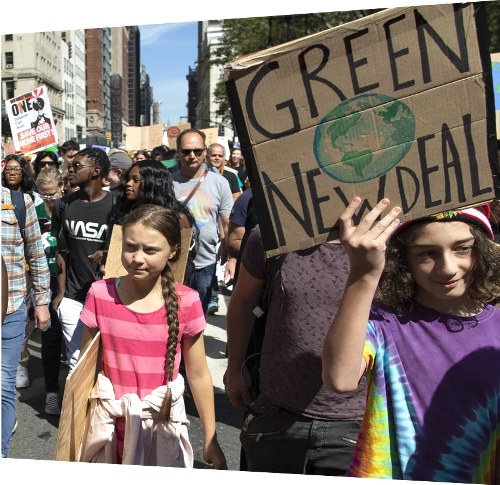
10. Obviously, we will not change the mode of production without the producers, and a fortiori against them. This means that the major strategic question is more than ever the commitment of the labour movement in the fight for the climate, and against the ecological catastrophe in general. Limited but significant facts have occurred in the last period, which deserve to be popularized because they show that this engagement is possible. For example: denying all forecasts, the “yellow vests” in France and the climate movement have converged in the fight against the Macron government; defying Jeff Bezos, the highly skilled workers at Amazon headquarters in Seattle went on strike, protested at the call of Greta Thunberg, and demanded that the company commit to saving the climate; in Switzerland, in the canton of Geneva, union officials are working closely with the youth climate movement and the feminist movement in preparation for the “strike for the future” of May 15, 2020;… The pandemic and lockdown raise the question of unnecessary production that can and must stop, and of essential life support activities that are devalued as well as overwhelmingly carried out by women. The Fourth International calls on left-wing unionists to build on initiatives of this kind to raise awareness among their fellow workers in order to also engage them in ecosocial struggles. The objective to be pursued is to bring the workers movement to draw up its own book of demands, based on the way workers are impacted by climate change, both in their working conditions and in their living conditions in general and to organize for a just transition that means something.
11. In summary, the FI calls on its sections and supporters to organize the strongest possible mobilization around the COP26 events in Glasgow at the end of the year, and in the lead up throughout this year.
The FI reaffirms that it is imperative to achieve the emission cuts necessary to keep the temperature rise below 1.5°C. That includes the adoption of a new set of much more radical, nationally determined contributions, with a time frame centred on the coming decade, not on 2050, as well as a massive transfer of money to the Global South to finance climate justice.
Around COP26, it is a question of building mobilizations to challenge the elites to act to reverse the current situation and to reject their excuses for not doing so. Governments can make major changes fast when they decide to do so – for example, to wage war, they can transform their economies within months. The Covid crisis itself has also taught us is that governments can find vast sums of money when they decide to do so.
The points of support and proposals for mobilization include:
a) The second edition of the COP26 Coalition’s event, From The Ground Up, around Earth Day 22 April, this time entitled “Taking Action Now” and aimed at developing plans for mobilization, locally and globally.
b) Maximum mobilization for the Glasgow COP itself. Depending on the possibilities, this might include physical demonstrations in Glasgow and some other parts of the world, decentralized actions elsewhere, plus an online convergence instead of a People’s Summit in Glasgow itself.
c) The Glasgow Agreement process.
d) The proposal for a global climate strike made by the Global Ecosocialist Network in connection with the COP26 conference in Glasgow in November 2021.
On the basis of the activity and perspectives in the different countries a specific meeting will specify our proposals for the construction of the mobilization. •
Adopted (52 for 4 NV) by the International Committee of the Fourth International.


